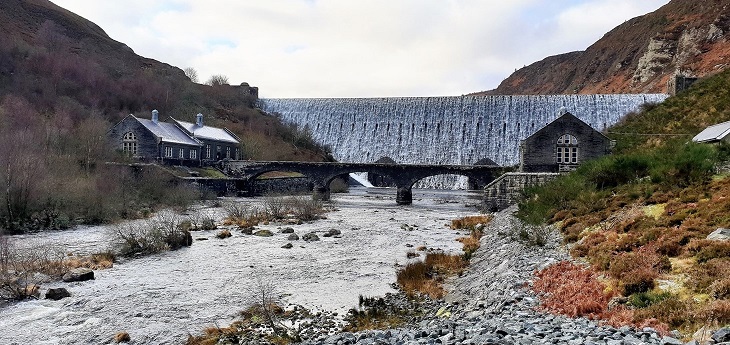These articles are now archived and will no longer be updated.

The Caban Coch Dam, Elan Valley, Wales (Picture: Sara Barrento).
New research has found that Europe’s rivers are the most fragmented in the world, with up to one million barriers blocking their flow, and urgent action to reconnect them is now vital to ensure the long-term health of these rivers and their surrounding habitats.
The research findings were shared by the EU Horizon 2020 project Adaptive Management of Barriers in European Rivers (AMBER) today (29th June) with the launch of the first-ever pan-European Atlas of in-stream barriers. The Atlas is a major, multi-year international achievement and the first of its kind, given the depth of analysis at a continental scale.
The AMBER barrier Atlas provides the most comprehensive overview of river fragmentation in Europe. It contains information on 630,000 barriers including not only large dams, but also hundreds of thousands of smaller weirs, ramps, fords and culverts.
However, after walking 2,700 km of streams in 28 countries, AMBER researchers made the following key findings:
- More than one third of barriers are unrecorded.
- The total number of barriers is well over 1 million.
- Europe has the most fragmented river landscape in the world, with hardly any unfragmented, free-flowing rivers left.
Barriers come in all shapes and sizes, and for good reason. Weirs, small hydropower structures, big dams, culverts and fords provide drinking water, irrigation, energy production, flood protection and help us cross rivers. But healthy rivers are flowing rivers, and these barriers break the flow, fragment waterways, isolate habitats and weaken wildlife populations.
Carlos Garcia de Leaniz, AMBER project coordinator and Professor of Aquatic Biosciences at Swansea University said: “Even areas that were considered to be relatively pristine and well connected are in fact impacted by barriers. For example, in the Balkans, our field validation indicates that 80% of barriers do not appear in current inventories, making the fragmentation of these rivers much worse than people thought.”
The atlas data can be used to estimate river fragmentation at various spatial scales. Together with several restoration tools specifically developed by the AMBER consortium, this information can help river basin managers minimize the impacts of barriers.
For example, AMBER research indicates that most of the loss of connectivity is typically caused by a relatively small fraction of barriers, so it makes sense to prioritize these. The priority should be to protect the least fragmented rivers and to act on those barriers that cause most of the damage.
Traditionally, river managers have tended to view river fragmentation as being caused solely by large dams, but AMBER researchers have found this is seldom the case:
- In Europe, over 85% of barriers are weirs and other small structures, not dams.
- Many of these are out of use, and could be removed as they break river connectivity and block the movement of sediments and organisms.
- Other barriers provide hydropower, water for irrigation, fishing and leisure opportunities and many other services needed by society.
- The challenge will be maximize the benefits of such barriers and to minimize their impacts through adaptive management.
The researchers say that if just 2.5% of these small barriers were removed, then 25,000 km of rivers could be freed, and could meet the goals of the new EU Biodiversity Strategy for 2030.
Barbara Belletti who led the development of the AMBER Atlas at Politecnico di Milano along with Wouter van de Bund at the Joint Research Centre of the European Commission, said: “Over 60% of EU freshwater systems are in a poor state in part due to habitat fragmentation. To improve the health of our rivers, we need to reconnect them—our Atlas and tools will support this endeavour.”
